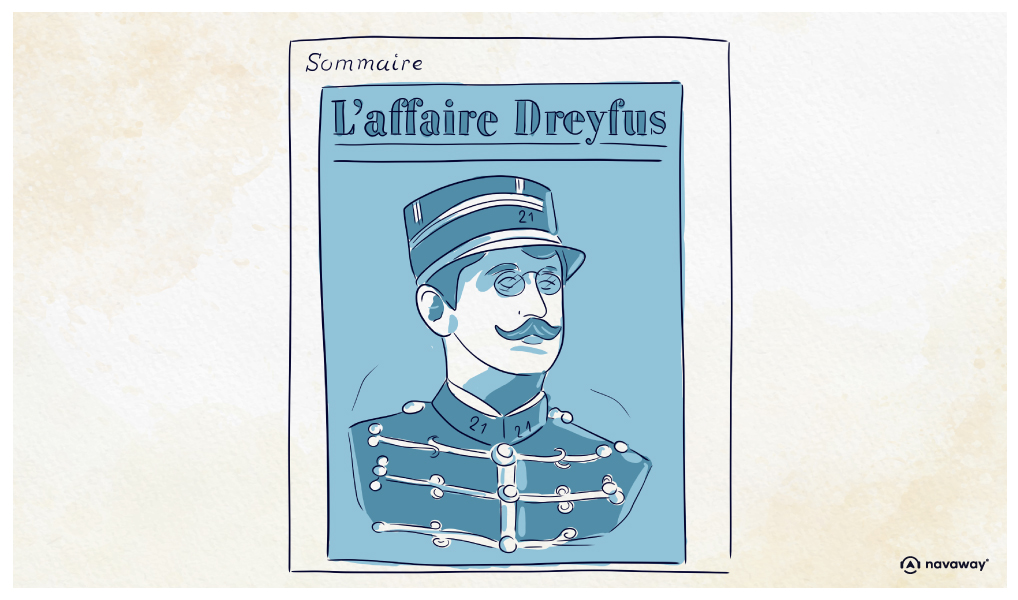
L’affaire Dreyfus

This point of interest is available as audio on the tour: Visit Rennes, Queen Of Britanny
You are in Captain Alfred Dreyfus Street, close to the Emile Zola high school. You might not know it, but Rennes was the site of the retrial of the notorious Dreyfus affair. It’s a good opportunity to take a look back at this incredible story, that shook France, and brought to light the most significant legal malpractice of the 20th century! You might be familiar with the key features, however if you wish to know more, I suggest you sit on one of the benches near the church and allow me to recount this famous story!
It all started in Paris, in 1894. At that time, a german soldier, Maximilien Von Schartzkoppen, worked at the embassy of his country. His misision was to gather as much information about the french army as possible. What he didn’t know was that his housemaid, Marie Bastian, was a member of the french counter-espionage. One day, she found a torn letter in the paper bin. This anonymous note promised Maximilien a whole bunch of highly confidential information on the french artillery. The head of counter espionage immediately contacted the Minister of War, to start an investigation. However, the search didn’t last very long, as the ideal culprit appeared quickly : an artillery officer named Alfred Dreyfus. They had many reasons to think so. First of all, he was from Alsace. When Germany had taken the Alsace-Lorraine region, Dreyfus fled to come back to France, but investigators saw him more as a spy working for Germany. Second of all, Dreyfus rose through the ranks quickly, another dubious fact. Finally, as you surely know , he was jewish. There was no actual proof against him, the handwriting was of course no where close to his own and Dreyfus claimed his innocence. If you thought the trials of the Inquisition were ancient history, you haven’t seen anything yet! A relentless machine was set into motion. I’ll spare you the details, but it was a succession of misled investigations, fake allegations and falsified reports. They weren’t considering any other suspect , they had one at hand! An anti-semitic campaign started spreading across the country. The trial was lost from the start. . Since there is no incriminating evidence against the accused, the army wields an infallible weapon: a file supposedly containing irrefutable proof of his guilt, but kept top-secret.
We know today that this file was empty. Dreyfus was stripped of his rank in front of a massive crowd, and sent to a life sentence in a penal colony off the coast of Guyana, where he barely survived under terrible conditions. However, in 1896, counter-espionage found a new document intended for Maximilien, and it’s quite clear that Dreyfus wasn’t sending it. The new investigation eventually found the real culprit of the whole affair, a certain Commander Esterhazy. The latter was hastily tried and acquitted without causing any stir. In the height of injustice, it was Colonel Picard, the one to expose Esterhazy, who ended up imprisoned! The case became political. Ministers and General army Staff got involved. They couldn’t admit to having condemned an innocent man. At the same time, antisemitism in France was at its peak, and newspapers were in a frenzy. Public opinion started splitting between Dreyfusards and Antidreyfusards. It is very likely the largest political divide ever recorded in France. Numerous political figures supported the Dreyfusards, such as Leon Blum, Clémenceau, but most importantly, Emile Zola, then at the peak of his fame.. He published his famous “J’accuse,” an open letter to the President of the Republic, on the front page of the newspaper L’Aurore. Usually printed in 30,000 copies, more than 300,000 copies were sold. Although his powerful and courageous “J’accuse” still resonates today, know that Zola was prosecuted and accused of defamation. Thus his message was heard loud and clear, and people were made aware of the inconsistencies of the story and of Esterhazy’s guilt. A retrial was inevitable. This time it took place in Rennes and was highly publicized. The story could have ended there, but Dreyfus was once again found guilty and sentenced to 10 years in prison before finally being pardoned. He was only fully exonerated in 1906. He lived through World War I and died in 1935. This concludes our historical recap of this event that had such a significant impact on French society ! Let’s get back to the present, and resume our visit of Rennes.


Discover Rennes with app
An interactive guide through the most beautiful streets, squares, and districts
25 fun audioguides full of historical facts, anecdotes, and legends





Comments